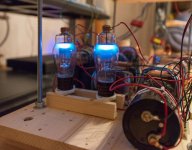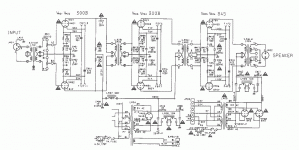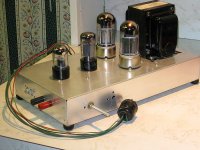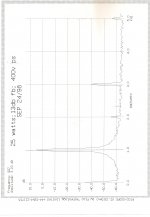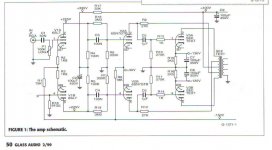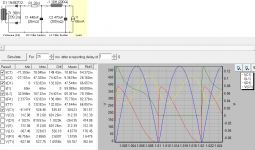I came across this web page:
Space-Tech Laboratory - High-End Audio
Ok, it has made me lol quiet a bit...trying to think what really is in the box for 1600$...I guess he will have different heater transformers in there...and some sockets in a box....for 1600...
...as well considering a 872A for preamp usage sounds bizarre...the guy is much crazier than me and that teaches me respect.
but seriously: the test-possibilty of even triodes and more reasonable types sounds interesting...considering that different filaments and coatings would be available. Do u connect g1 to the cathode when converting a triode to diode or leave it unconnected ?
So, besides the entertainment aspect of all of that: Has anyone listening experiences with such a setup ?
Space-Tech Laboratory - High-End Audio
Ok, it has made me lol quiet a bit...trying to think what really is in the box for 1600$...I guess he will have different heater transformers in there...and some sockets in a box....for 1600...
...as well considering a 872A for preamp usage sounds bizarre...the guy is much crazier than me and that teaches me respect.
but seriously: the test-possibilty of even triodes and more reasonable types sounds interesting...considering that different filaments and coatings would be available. Do u connect g1 to the cathode when converting a triode to diode or leave it unconnected ?
So, besides the entertainment aspect of all of that: Has anyone listening experiences with such a setup ?
So, besides the entertainment aspect of all of that: Has anyone listening experiences with such a setup ?
If you are hoping to find someone who actually bought this, and who can also give a balanced review that even approaches a blind test scenario, then good luck as I think you will find those a mutually exclusive target groups.
6AS7/6080 would work well as a rectifier. The very large cathodes are a plus.
But better utilized in a PP amp.
Sweep tubes work even better.
I agree the 6AS7 is better left to push pull, one of my favorite applications of any tube is 6AS7 push pull outputs.
If you are hoping to find someone who actually bought this, and who can also give a balanced review that even approaches a blind test scenario, then good luck as I think you will find those a mutually exclusive target groups.
No I do not expected that anyone here would sink his $$$ into this company, but I would hope to learn from the experiences of other who built something similar in a DIY effort and have an impression.
So, Triode as rectifiers means g1 to cathode or g1 open ? And Sweep tubes: g1 on cathode and g2 at anode I guess ? Correct ? Maybe I will play with this, I am just building a universap PSU to test drive all kind of setups...
Not only didn't I continue with triodes, I have since changed to solid state rectifiers. I have used vacuum rectifiers for a long time. I even have a stock of TV damper diodes that are still in their boxes.I would hope to learn from the experiences of other who built something similar in a DIY effort and have an impression.
There are reasons for preferring vacuum diodes that aren't logical that you'll want to watch to keep your tests fair. Eg, their resistance can damp transformer ringing and the problems it can cause. This can be adjusted using resistors, even with a solid state supply so I feel there doesn't need to be mystery surrounding this.
Well, I would be more than happy to use SS diodes as you say if there is a bullit-proof circuit where they outperform tubes sonically.
I tried all kinds of SS diodes like Hexfred, Cree etc. But when I change even from Hexfred to a (russian) Gz34 bridge (so four of them): Much more dynamics and fine deteils, air and transparency. I really do not want the extra complexity, but sofar I tubes are in the lead...so, if there is a trick missing to make SS sound much better, let me know (I know the Hagerman-Paper).
I tried all kinds of SS diodes like Hexfred, Cree etc. But when I change even from Hexfred to a (russian) Gz34 bridge (so four of them): Much more dynamics and fine deteils, air and transparency. I really do not want the extra complexity, but sofar I tubes are in the lead...so, if there is a trick missing to make SS sound much better, let me know (I know the Hagerman-Paper).
Much more dynamics and fine deteils, air and transparency.
A lot of people do not hear this, or find it easy to persuade themselves it doesn't matter. And...problem solved
6AS7/6080 works well as an amplifier also. The very large cathodes are a plus. Here is my run at it. 30W at klipping.
Published in Glass Audio #2, 1999
Published in Glass Audio #2, 1999
Attachments
This is a choke input supply, despite the R and C before the choke. This layout has worked for me in low Voltage bias supplies and high current SS amp supplies. Also check out the fleshed out version here. The devil is in the details and the values need to be right to get the best results.
Attachments
Last edited:
Steve Bench did some very interesting audio amps wherein he used vacuum diodes in the cathodes of triodes as a biasing resister. All part of his no Cs, no Rs project.
Here is a link to some really interesting stuff-
Steve's Tube Pages
Here is a link to some really interesting stuff-
Steve's Tube Pages
Space-Tech Lab has a Vancouver phone number, Area 604. They are probably bringing their stuff in from China or SE Asia.
I discovered a guy in SE Asia building a clone of that 2X6080 cct I posted above. Got an email from someone in Europe looking for help, his amp had smoked. He had read my article in Wireless World & tracked me down.
Top side of the amp looked OK. But below was a mess of cooked bias resistors. The builder had gone cheap. The amp fried.
I discovered a guy in SE Asia building a clone of that 2X6080 cct I posted above. Got an email from someone in Europe looking for help, his amp had smoked. He had read my article in Wireless World & tracked me down.
Top side of the amp looked OK. But below was a mess of cooked bias resistors. The builder had gone cheap. The amp fried.
Blitz, the problem with the Space-Tech link is that there is no technical information other than 'triode' and 'diode', so even if others have tried using a triode based circuit in place of a diode, any such triode circuit could be very different from any other or from what Space-Tech is using.
There is a lot more involved in making a power supply not egress anything more than DC voltage than just 'diode rolling'. The link includes a discussion on the influence of diodes and diode commutation - effectively focussing on the area of the power supply before any filtering and regulation normally start.
https://www.dalmura.com.au/static/Power%20supply%20issues%20for%20tube%20amps.pdf
There is a lot more involved in making a power supply not egress anything more than DC voltage than just 'diode rolling'. The link includes a discussion on the influence of diodes and diode commutation - effectively focussing on the area of the power supply before any filtering and regulation normally start.
https://www.dalmura.com.au/static/Power%20supply%20issues%20for%20tube%20amps.pdf
6AS7/6080 would work well as a rectifier. The very large cathodes are a plus.
But better utilized in a PP amp.
Have done that. But even the relatively high voltage rating between heater and cathode (300V) limits its use to lower voltage supplies. Could of course use a separate supply for the heater...
In guitar amp world theres lots of talk and magic surrounding rectifiers and 'sag' for long sustain and a certain feel. So I intended to regulate the rectifier internal resistance (and thus 'sag') by controlling the cathode-grid voltage of the 6AS7. But I never got around to any more than some experimentations on the bench and never tried it in practice.
The venerable Marantz used 300Bs as rectifiers, right? Perhaps made sense as practically everything in that amp was done right.
I still somehow doubt this approach beats good mercury outside of sissy pc company
That's news to me. Must be something new made by VSAC or in Japan I guess. Nothing made by Marantz back in the day used 300B as rectifiers, damper tubes, selenium, and silicon were used.. Tube gear in those days was engineered, there were no boutique makers here at the time.
The 211 was widely used as a rectifier because there were apparently no suitable high voltage high vacuum rectifiers until the early 1930s. You see this in early theater amps.
The grid and plate would be tied together.
- Status
- This old topic is closed. If you want to reopen this topic, contact a moderator using the "Report Post" button.
- Home
- Amplifiers
- Power Supplies
- Super Tube Rectifier (triodes as diodes etc.)
